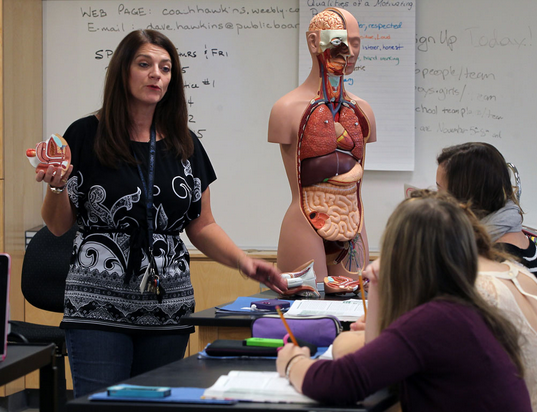[captionpix imgsrc=”https://pvnn.org/wp-content/uploads/2015/07/chrisabstinence.png” captiontext=”Photo courtesy of WordPress.com”]
The Center for Disease Control (CDC) reported that the 2013 birth rate was 26.5 percent, per one thousand females, for teenage girls alone – the highest of western industrialized nations. [ref]”About Teen Pregnancy,” Centers for Disease Control and Prevention, June 9, 2014, accessed July 21, 2015, http://www.cdc.gov/teenpregnancy/about/index.htm[/ref] In response, Congress including a provision in the recent Medicare bill that would provide fifty million dollars to Title V programs, or abstinence-only programs, that encourage adolescents to delay intimacy until marriage. While it seems like a lot of money, $1.7 billion dollars has already been spent on abstinence-only lessons since 1982.[ref]”U.S. Government Is Still Funding Dubious Abstinence-Only Sex Education Program,” July 6, 2015, accessed July 19, 2015, http://www.allgov.com/news/where-is-the-money-going/us-government-is-still-funding-dubious-abstinence-only-sex-education-program-150706?news=856889[/ref] Recent data from the Gutt Macher Institute revealed that twenty-three percent of adolescent females, and twenty eight percent of adolescent males, received abstinence-only education, without any instruction about birth control. This shows a dramatic increase since 1995, when eight to nine percent of all adolescents were students of abstinence-only curriculum. Indeed, abstinence-only education is on the rise, but is it effective?[ref]”Facts on American Teens’ Sources of Information About Sex,” Facts on American Teens’ Sources of Information About Sex, February 1, 2012, accessed July 19, 2015, https://www.guttmacher.org/pubs/FB-Teen-Sex-Ed.html[/ref] According to a 2014 research article published by the Journal of Pediatric Adolescent Gynecology, states implementing such policies showed a birth rate of 39.8 percent, out of a thousand, while states not carrying these policies revealed a 45.1 percent out of a thousand rate. These statistics reveal that state policies on sex education had little to no impact on the rate of teen births.[ref]M. Chevrette and H. Abenhaim, “Do State-Based Policies Have an Impact on Teen Birth Rates and Teen Abortion Rates in the United States?” Journal of Pediatric Adolescent Gynecology, 2014.[/ref] Abstinence-only programs use the tax payer money to push on a belief rather than practical useful knowledge. The Vendetta, therefore, is how to effectively decrease the teen pregnancy rate while saving tax payer’s money.
Advocates for abstinence-only education argue that there is actual value to these programs. One report released by the Consortium of State Physicians Resource Councils, for example, listed six studies that lead to positive effects for abstinence-only programs. Yet out of these six studies, only one was a peer-reviewed article published within the last twenty years. In fact, the most recently published article in the journal was not actually a study on abstinence-only programs, but rather a survey revealing that a pledge of abstinence was the most likely factor in prolonging the initiation of sexual activity. Another study of an abstinence-only program evaluated the “Postponing Sexual Involvement” curriculum, which is a five-session lesson taught by adults or peers, and was implemented in California. Reports conveyed that students who were taught by peers were more likely to get someone pregnant, or to become pregnant themselves. The study ultimately proved that the program had no significant impact on the initiation of sex, the frequency of sex, or the number of sexual partners.
Besides promoting a non-effective program, the government, while funding abstinence-only education, is essentially endangering the health of young adolescents. In fact some of these programs have been known to present false information. In one case, an abstinence speaker was invited to Bozeman High School in Montana for an assembly, who then proceeded to inform the students that condoms cause cancer and that Sexually Transmitted Infections (STI’s) can be transmitted through skin contact. The speaker also informed students that birth control was only twenty percent effective, and can cause cervical cancer and sterility.[ref]“Teens in Montana Told that Condoms Cause Cancer,” Feministing, 2005, accessed July 19, 2015, http://feministing.com/2005/05/12/teens_in_montana_told_that_con[/ref] Of course, this information was all false, and in fact if taken correctly birth control pills are about ninety-nine percent effective. [ref]”Birth Control Pills – Types, Effectiveness, and Side Effects of Birth Control Pills,” WebMD, accessed July 19, 2015.[/ref]
Comprehensive sex education has proven more effective than abstinence-only programs. While also promoting abstinence, comprehensive sex education also provides information about contraceptives and Sexually Transmitted Diseases (STD’s). A federally-funded evaluation of four abstinence-only programs revealed that the certain youth were not less likely than general adolescents to delay sexual initiation. With that said, without the inclusion of contraceptives and STD’s, abstinence-only programs deny youth the information needed to protect their health. In 2001, Surgeon General David Satcher revealed that comprehensive sex education did not increase sexual activity among adolescents, and that some of these programs increased the use of condoms or contraceptive use for adolescents who were sexually active. In other words, teenagers who underwent comprehensive sex education, and were sexually active, were actually safer than those who only attended abstinence-only programs.[ref]Chris Collins, Priya Alagiri, and Todd Summers, “Abstinence Only vs Comprehensive Sex Education,” AIDS Policy Research Center and Center for AIDS Prevention Studies, 2002.[/ref]
While parents should ultimately choose how their child receives information about sex, sexual education should adopt a more critical public health focus. As previously mentioned, because types of sex education does not influence the rate of sex, the government should instead take a lesson from comprehensive sex education, and mainly focus on promoting healthier behaviors. As stated before, the 2013 birthing rate of 26.5 percent out of one thousand teenage girls. This statistic is actually a ten percent decrease from 2012. This decrease, in turn, is mostly attributed to sexually active teens using birth control and practicing safe sex. At the same time, parents should still be able to opt out of these types of education and teach their own child how they see fit.
Take Action:
This petition takes a stance that health options are what prevent teen pregnancy, not abstinence-only programs. Sign the petition to help efforts to prevent the push for abstinence -only programs.
This petition fights to repeal ineffective abstinence-only education. This petition is to be delivered directly to the United States House of Representatives.




